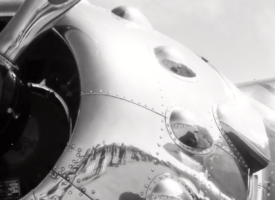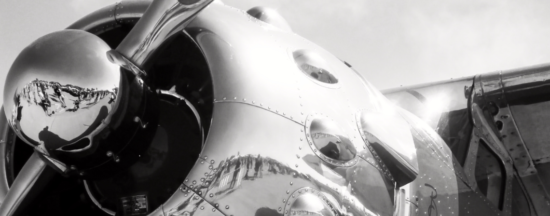Borders and Bridges
By PhD Lucas Mazur, visiting professor for empirical social research and organizational psychology
This year we are celebrating the 70th anniversary of the Berlin Airlift. I was sorry to learn that I would not be in Berlin during the celebration of this important historical event. However, after speaking with colleagues at the Sigmund Freud University in Berlin, we thought that I might be able to symbolically join you electronically, from the other side of the Atlantic Ocean in Buffalo, New York — hence this brief text and video.
Connecting with you in this way from across the Atlantic also seems particularly appropriate given that we are now marking the 70th anniversary of the Berlin Airlift, whereby the Allies stood by their then-new partners in what became known as West Berlin. Currently, I am not far from the Niagara Falls Airforce Base which provided support to that undertaking 70 years ago. Seventy years later, this message is being sent along the same path – albeit by different means – from the US to Germany, from Buffalo to Berlin.
We are celebrating a particular historical event, but also a perennial part of human life.
As an American who lives and works in Europe, not only have I been personally fascinated by the different languages, cultures, and peoples on these two continents, but I have benefited in countless ways from the bridges we have built over the last half century between us. This is the theme that I would briefly like to talk with you about today – borders and bridges. This theme lies at the heart of the Berlin Airlift, and this is what we are celebrating today. We are celebrating a particular historical event, but also a perennial part of human life. In that sense, the celebration today is not only a celebration of a historical hurdle overcome, but also of the human capacity to overcome the challenges of human difference that will always be found on our path, that is, provided we have the fortitude, wisdom, patience, and commitment to do so.
The monument captures the experience of division, but also the desire to reach across that divide
As you all know, in German the Berlin Airlift is known as the “Berlin Air Bridge.” The monument that stands in front of the Tempelhof Airport, the site of the Berlin Airlift, reflects this linguistic difference as it resembles a bridge stretching across the skies. While one side of the bridge is firmly grounded, the other end of the bridge stretches out into the sky, reaching as it were for the other side. This is what makes this monument so beautiful. It captures the experience of division, but also the desire to reach across that divide. There is a fundamentally important message here. Bridges do not remove divisions. They do not breakdown borders. Perhaps ironically, they are actually grounded on such opposites, on opposite sides, and their very stability – let alone their purpose – is founded on that divide. Bridges connect us, not by filling in the gaps that separate us, but by respecting that space, while simultaneously allowing us to transverse the divide – each to the other.
As a social psychologist, I have been studying how we come to understand collective experiences, particularly experiences of large-scale violence. A considerable body of psychological research has suggested that the formation of meaningful narratives around such traumatic experiences can help people to constructively work through the challenges such experiences can create. This appears to be true for both individuals and collectives. It also appears to be true for people experiencing various degrees of psychological distress – from extreme trauma, such as that related to PTSD, to more common experiences of depression.
Memory is a process – often a social process
How does this work? How can something as simple as a meaningful narrative help relieve such serious challenges? Acknowledging the more complex social psychological processes involved, we can say that part of what allows this to work is that narratives help to provide structure to that which would otherwise remain formless, often chaotic, and for many overwhelming. A narrative is often a centrally important part of the process by which we can make even the most overwhelming of experiences manageable. What is interesting to note is that narratives are always necessarily more simplistic than the wider reality of the lived experiences. Narratives are impoverishments of the data, if you will. But therein lies their magic. Similarly, over the last several decades, psychological research has increasingly showed that remembering and forgetting are in many ways two sides of the same coin, and that both are an important part of healthy psychological and interpersonal functioning. A health memory is not a memory which never fails, with all fact preserved as if in a photograph. Rather, a healthy memory is considerably plastic, malleable, meaning that it is just rigid enough to serve as a useful tool, but that it is not overly ridged so as to render it inflexible in the face of changing demands placed up on it – both from ourselves and from the outside world. Importantly, memory is a process – often a social process. In other words, memory is not a thing that is, but a process that is done, and the doing of memory always takes place within a particular context.
Why is this important for us today? The borders that we impose on a vastly more complex reality can be tremendously valuable. The diversity of identities, ideas, visions, and understandings are a source of power. They help us make sense of an overwhelming world, and they allow us to find meaning in our lives. Problems for psychological and social functioning can arise when we are unable to impose borders, but they can also arise when those borders become too rigid and impermeable. In as far as we value psychological health and harmonious interpersonal and intergroup relations, we are thus forced to find the balance between rigidity and malleability. Borders can close down dialogue and keep us apart, but they also allow for the very notion of dialogue and cooperation – and even unification. Tolerance, friendship, compassion, and cooperation are possible precisely because of the differences between us, precisely because they afford us the opportunity to stretch our hand across the divide – just as we see in the monument to the Berlin Air Bridge in front of Tempelhof Airport. This is not an easy task, but it is an important one.
What is more, because these divisions appear to be part of human psychological functioning, healthy psychological functioning, we can expect the challenge of diversity and divisions to be with us for as long as we are around. We need not protect ourselves with ostensibly impregnable walls, nor need we presume some fanciful homogeneity of humanity. Rather than merely respecting the differences between us, we should be thankful for them, as they afford us the opportunity to build bridges.
The challenge of borders and bridges
The challenge of borders and bridges is not only applicable to international relations or psychological health, but to a wide range of phenomena. For example, roughly one hundred years ago adolescence was a new concept, a concept that arose from our renegotiation of childhood (which itself was a new concept before it). As we look out at the social world today, we are starting to draw new borders around a new age group, namely, emerging adulthood, giving it new meanings, new ways of seeing, and being in, the world. Similarly, regardless of whether psychologists break up the world with qualitative or quantitative methods, we are forced to acknowledge the limitations of our methodological tools, however, while also capitalizing on their strengths. As new categories are constructed, new bridges need be built. This is not to say that the contours of these outlines are hard and fast – far from it. Rather, this illustrates how such borders are fluid, while at the same time gaining their power from the clarity they provide.
The Berlin Airlift, the Berlin Air Bridge, and the Tempelhof Airport more broadly, speak to the power in bridging divisions. Divisions and differences will always be part of human life. It is up to us to rise to the challenge of reaching across the divide.
It is no wonder that the Sigmund Freud University in Berlin has taken the Berlin Air “Bridge” monument as its unofficial symbol. An Austrian University operating in six different European nations, the SFU values and capitalizes on diversity, diversity of all kinds; theoretical, methodological, political, ethnic, national, and so on. The SFU sees strength in diversity, strength in extending a hand and an invitation.
I am very proud to be affiliated with an institution such as the SFU, with its faculty and study body, and I am honored to be working at such a historically important location as the Flughafen Tempelhof. Thank you for allowing me to join you there in Berlin today, from the other side of the Atlantic Ocean in New York. Thank you for extending a hand to me.
Weitere Infos zum Studium der Psychologie.


 Zurück zur Übersicht
Zurück zur Übersicht